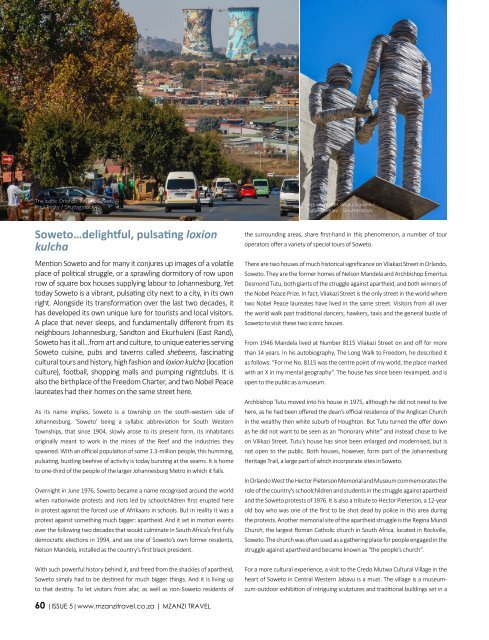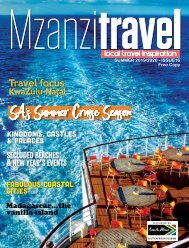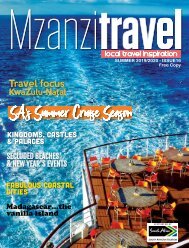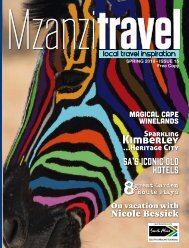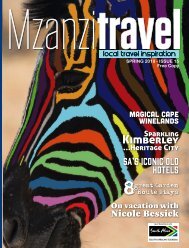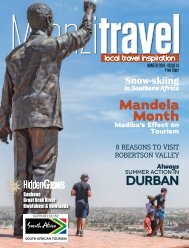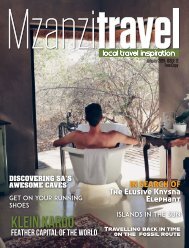Mzanzi Travel - Local Travel Inspiration (Issue 5)
MZANZI TRAVEL is a full-colour quarterly, A4 publication that sets out to showcase, foster and promote whatever South Africa has to offer to both local and international tourists.
MZANZI TRAVEL is a full-colour quarterly, A4 publication that sets out to showcase, foster and promote whatever South Africa has to offer to both local and international tourists.
Create successful ePaper yourself
Turn your PDF publications into a flip-book with our unique Google optimized e-Paper software.
Explore Africa<br />
The iconic Orlando Towers, Soweto/<br />
Paul Trinity / Shutterstock<br />
Art on Walter Sisulu Square /<br />
Sean Heatley / Shutterstock<br />
Soweto…delightful, pulsating loxion<br />
kulcha<br />
Mention Soweto and for many it conjures up images of a volatile<br />
place of political struggle, or a sprawling dormitory of row upon<br />
row of square box houses supplying labour to Johannesburg. Yet<br />
today Soweto is a vibrant, pulsating city next to a city, in its own<br />
right. Alongside its transformation over the last two decades, it<br />
has developed its own unique lure for tourists and local visitors.<br />
A place that never sleeps, and fundamentally different from its<br />
neighbours Johannesburg, Sandton and Ekurhuleni (East Rand),<br />
Soweto has it all…from art and culture, to unique eateries serving<br />
Soweto cuisine, pubs and taverns called shebeens, fascinating<br />
cultural tours and history, high fashion and loxion kulcha (location<br />
culture), football, shopping malls and pumping nightclubs. It is<br />
also the birthplace of the Freedom Charter, and two Nobel Peace<br />
laureates had their homes on the same street here.<br />
As its name implies, Soweto is a township on the south-western side of<br />
Johannesburg, ‘Soweto’ being a syllabic abbreviation for South Western<br />
Townships, that since 1904, slowly arose to its present form, its inhabitants<br />
originally meant to work in the mines of the Reef and the industries they<br />
spawned. With an official population of some 1.3-million people, this humming,<br />
pulsating, bustling beehive of activity is today bursting at the seams. It is home<br />
to one-third of the people of the larger Johannesburg Metro in which it falls.<br />
Overnight in June 1976, Soweto became a name recognised around the world<br />
when nationwide protests and riots led by schoolchildren first erupted here<br />
in protest against the forced use of Afrikaans in schools. But in reality it was a<br />
protest against something much bigger: apartheid. And it set in motion events<br />
over the following two decades that would culminate in South Africa’s first fully<br />
democratic elections in 1994, and see one of Soweto’s own former residents,<br />
Nelson Mandela, installed as the country’s first black president.<br />
the surrounding areas, share first-hand in this phenomenon, a number of tour<br />
operators offer a variety of special tours of Soweto.<br />
There are two houses of much historical significance on Vilakazi Street in Orlando,<br />
Soweto. They are the former homes of Nelson Mandela and Archbishop Emeritus<br />
Desmond Tutu, both giants of the struggle against apartheid, and both winners of<br />
the Nobel Peace Prize. In fact, Vilakazi Street is the only street in the world where<br />
two Nobel Peace laureates have lived in the same street. Visitors from all over<br />
the world walk past traditional dancers, hawkers, taxis and the general bustle of<br />
Soweto to visit these two iconic houses.<br />
From 1946 Mandela lived at Number 8115 Vilakazi Street on and off for more<br />
than 14 years. In his autobiography, The Long Walk to Freedom, he described it<br />
as follows: “For me No. 8115 was the centre point of my world, the place marked<br />
with an X in my mental geography”. The house has since been revamped, and is<br />
open to the public as a museum.<br />
Archbishop Tutu moved into his house in 1975, although he did not need to live<br />
here, as he had been offered the dean’s official residence of the Anglican Church<br />
in the wealthy then white suburb of Houghton. But Tutu turned the offer down<br />
as he did not want to be seen as an “honorary white” and instead chose to live<br />
on Vilikazi Street. Tutu’s house has since been enlarged and modernised, but is<br />
not open to the public. Both houses, however, form part of the Johannesburg<br />
Heritage Trail, a large part of which incorporate sites in Soweto.<br />
In Orlando West the Hector Pieterson Memorial and Museum commemorates the<br />
role of the country’s schoolchildren and students in the struggle against apartheid<br />
and the Soweto protests of 1976. It is also a tribute to Hector Pieterson, a 12-year<br />
old boy who was one of the first to be shot dead by police in this area during<br />
the protests. Another memorial site of the apartheid struggle is the Regina Mundi<br />
Church, the largest Roman Catholic church in South Africa, located in Rockville,<br />
Soweto. The church was often used as a gathering place for people engaged in the<br />
struggle against apartheid and became known as “the people’s church”.<br />
With such powerful history behind it, and freed from the shackles of apartheid,<br />
Soweto simply had to be destined for much bigger things. And it is living up<br />
to that destiny. To let visitors from afar, as well as non-Soweto residents of<br />
For a more cultural experience, a visit to the Credo Mutwa Cultural Village in the<br />
heart of Soweto in Central Western Jabavu is a must. The village is a museumcum-outdoor<br />
exhibition of intriguing sculptures and traditional buildings set in a<br />
60 |ISSUE 5|www.mzanzitravel.co.za | MZANZI TRAVEL


